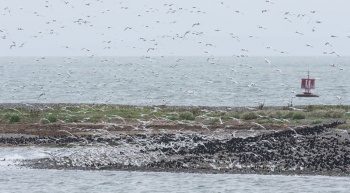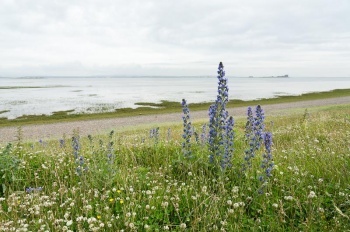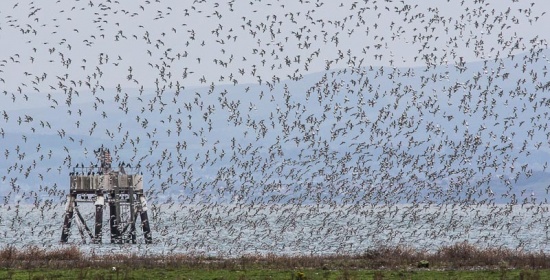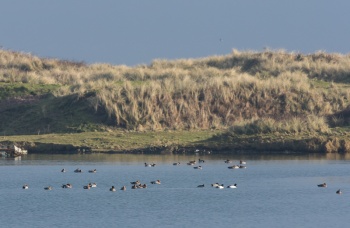Andreadawn (talk | contribs) |
Andreadawn (talk | contribs) |
||
| Line 14: | Line 14: | ||
[[Image:DSC_6899-3.jpg|thumb|350px|right|[[Eurasian Wigeon]] and [[Common Goldeneye]] on the lagoons<br />Photo by {{user|andreadawn|andreadawn}}<br />South Walney, January]] | [[Image:DSC_6899-3.jpg|thumb|350px|right|[[Eurasian Wigeon]] and [[Common Goldeneye]] on the lagoons<br />Photo by {{user|andreadawn|andreadawn}}<br />South Walney, January]] | ||
| − | Morecambe Bay is of international importance for passage and wintering waders and many of these form roosts on southern Walney. The island once had Europe's largest colony of [[Herring Gull]] and [[Lesser Black-backed Gull]] but numbers have declined substantially in recent years. In 2016 there were just over 3000 pairs of Herring and Lesser Black-backed combined. Virtually all of these birds nest on the spit at the extreme south eastern end of the island. The spit is not accessible to visitors but can be viewed from the areas around Pier Hide and the (currently closed) Groyne Hide. A scope is very helpful here | + | Morecambe Bay is of international importance for passage and wintering waders and many of these form roosts on southern Walney. The island once had Europe's largest colony of [[Herring Gull]] and [[Lesser Black-backed Gull]] but numbers have declined substantially in recent years. In 2016 there were just over 3000 pairs of Herring and Lesser Black-backed combined. (In 2018 there was a complete breeding failure of the gull colony). Virtually all of these birds nest on the spit at the extreme south eastern end of the island. The spit is not accessible to visitors but can be viewed from the areas around Pier Hide and the (currently closed) Groyne Hide. A scope is very helpful here. [[Common Eider]] are common breeding birds around the Islands of Furness and can often be seen in very large numbers around Walney with 4000 - 5000 birds sometimes present in winter. |
As well as Herring and Lesser Black-backed Gulls, there are smaller numbers of [[Great Black-backed Gull]] nesting at Walney and the spit on the southern tip has breeding [[Sandwich Tern]], [[Common Tern]] and [[Little Tern]]. Other breeders include [[Common Shelduck]], [[Eurasian Oystercatcher]] and [[Ringed Plover]]. | As well as Herring and Lesser Black-backed Gulls, there are smaller numbers of [[Great Black-backed Gull]] nesting at Walney and the spit on the southern tip has breeding [[Sandwich Tern]], [[Common Tern]] and [[Little Tern]]. Other breeders include [[Common Shelduck]], [[Eurasian Oystercatcher]] and [[Ringed Plover]]. | ||
Revision as of 04:01, 29 September 2018
Overview

Photo by andreadawn
South Walney seen from Pier Hide at high tide, early September.
The long and narrow Walney Island lies at the northern end of Morecambe Bay and is connected by a bridge to Barrow-in-Furness on the nearby mainland.
The northern part of the island is a National Nature Reserve, whilst the southern part is a nature reserve of the Cumbria Wildlife Trust. There is also a bird observatory in the south. Built from accumulated sand on glacial deposits, the habitats of the island include sand-dunes and shingle, marshes and open pools, saltmarsh and mudflats.
The Walney Observatory blog gives details of recent observations (see external links).
Birds
Notable Species
Morecambe Bay is of international importance for passage and wintering waders and many of these form roosts on southern Walney. The island once had Europe's largest colony of Herring Gull and Lesser Black-backed Gull but numbers have declined substantially in recent years. In 2016 there were just over 3000 pairs of Herring and Lesser Black-backed combined. (In 2018 there was a complete breeding failure of the gull colony). Virtually all of these birds nest on the spit at the extreme south eastern end of the island. The spit is not accessible to visitors but can be viewed from the areas around Pier Hide and the (currently closed) Groyne Hide. A scope is very helpful here. Common Eider are common breeding birds around the Islands of Furness and can often be seen in very large numbers around Walney with 4000 - 5000 birds sometimes present in winter.
As well as Herring and Lesser Black-backed Gulls, there are smaller numbers of Great Black-backed Gull nesting at Walney and the spit on the southern tip has breeding Sandwich Tern, Common Tern and Little Tern. Other breeders include Common Shelduck, Eurasian Oystercatcher and Ringed Plover.
Passerine migrants move through the area in large numbers in spring and autumn including pipits and wagtails, chats, warblers and flycatchers and rarities and subrarities are frequently seen. Black Redstart, Firecrest and Red-breasted Flycatcher are regularly seen.
Offshore there is much movement of seabirds including shearwaters and skuas and all the species of wader that occur in Morecambe Bay will appear at Walney or on nearby Piel Island. Many thousands are forced onto the spit at the southern tip of Walney by autumn and winter high tides. Divers and grebes appear in good numbers offshore during passage periods and winter.
Merlin, Peregrine Falcon and Short-eared Owl are regular hunters over the island in autumn and winter, often joined by Eurasian Sparrowhawk.
Rarities
Squacco Heron is among the many rarities seen on Walney Island in recent years.
Check-list
Birds you can see here include:
Red-throated Diver, Great Crested Grebe, Red-necked Grebe, Northern Fulmar, Manx Shearwater, Northern Gannet, Great Cormorant, Whooper Swan, Greylag Goose, Common Shelduck, Eurasian Wigeon, Common Teal, Mallard, Northern Pintail, Northern Shoveler, Greater Scaup, Common Eider, Common Scoter, Velvet Scoter, Common Goldeneye, Red-breasted Merganser, Eurasian Sparrowhawk, Common Kestrel, Merlin, Peregrine Falcon, Water Rail, Common Moorhen, Eurasian Oystercatcher, Ringed Plover, Eurasian Golden Plover, Grey Plover, Northern Lapwing, Red Knot, Sanderling, Curlew Sandpiper, Purple Sandpiper, Dunlin, Ruff, Jack Snipe, Common Snipe, Black-tailed Godwit, Bar-tailed Godwit, Whimbrel, Eurasian Curlew, Spotted Redshank, Common Redshank, Common Greenshank, Green Sandpiper, Wood Sandpiper, Common Sandpiper, Ruddy Turnstone, Arctic Skua, Black-headed Gull, Common Gull, Lesser Black-backed Gull, Herring Gull, Glaucous Gull, Great Black-backed Gull, Black-legged Kittiwake, Sandwich Tern, Common Tern, Little Tern, Common Guillemot, Razorbill, Black Guillemot, European Turtle Dove, Eurasian Collared Dove, Common Cuckoo, Little Owl, Short-eared Owl, Common Swift, Eurasian Skylark, Shorelark, Sand Martin, Barn Swallow, Northern House Martin, Meadow Pipit, Yellow Wagtail, Grey Wagtail, Pied Wagtail, Eurasian Robin, Black Redstart, Common Redstart, Whinchat, European Stonechat, Northern Wheatear, Eurasian Blackbird, Fieldfare, Redwing, Lesser Whitethroat, Common Whitethroat, Garden Warbler, Blackcap, Common Chiffchaff, Willow Warbler, European Greenfinch, Eurasian Linnet, Twite, Lesser Redpoll, Snow Bunting
Other Wildlife

Photo by andreadawn
South Walney, June
The shingle and dune plant communities of Walney are among the richest in Britain and include species such as Viper's Bugloss Echium vulgare, Yellow Horned-Poppy Glaucium flavum, Sea Beet Beta vulgaris maritima, Sea Campion Silene maritima, Sea Holly Eryngium maritimum, Sea Spurge Euphorbia paralias, Sea Bindweed Calystegia soldanella and Thrift Armeria maritima.
Less salt-tolerant plants such as Common Heather Calluna vulgaris and Cross-leaved Heath Erica tetralix, Tormentil Potentilla erecta, Gorse Ulex europaea and Bracken Pteridium aquilinum grow in the drier areas.
There are also large numbers of Grey Seals (Halichoerus grypus) around the south end of the island. Prior to 2015 the seals used the sands at the southern extremity of the island purely as a haul out site, with as many as two hundred sometimes present. However in 2015, two pups were born at the site, followed by five in 2016 and ten in 2017 so the site has now become a breeding colony. Unfortunately the colony site itself cannot be seen from any of the trails except for distant views near to the old Groyne Hide, but there is a webcam with views displayed on a monitor in one of the huts by the car park. At high tide the seals can often be seen in the water in front of the Pier Hide or beside the main track that follows the shore of the Walney Channel with good close views often possible.
Site Information
History and Use
To do
Areas of Interest
For the North Walney Nature Reserve where the rare Natterjack Toad Bufo calamita can be found, follow signs for North Walney and park at Earnse Point.
Large numbers of waders and waterfowl can also be seen from this part of the island during passage periods and in winter. A distinct form of the Bloody Cranesbill known as the Walney Cranesbill Geranium sanguineum lancastrense can be seen in the North Walney NR and at a few other places on the island.
Access and Facilities
The reserve is open all year, daily from 1000-1700 (1000-1600 in winter). With very high tides of greater than about 9.8 metres or with large storm surges the reserve may be cut off from the rest of Walney for a couple of hours around high tide.
To reach Walney Island follow the A590 to Barrow and cross the Jubilee Bridge from the dockyards to the island. Turn left and head south on Ocean Road, then left onto Carr Lane and keep going until a caravan park sign is reached, continue ahead on the minor road to the reserve car-park.
There are six hides in all around the marked trails each of which has its own particular habitats.
Following the marked trail leads past gravel-pits and shingle ridges to the Pier Hide overlooking the spit with terns in summer and waders at other times. The trail then leads past the lighthouse and along the seaward side of the island and back to the car-park.
The hides along this stretch of the trail offer excellent seawatching opportunities in season and can be especially productive after westerly gales (Groyne Hide is currently closed due to storm damage as is one of the screens overlooking the main lagoons).
Another trail leads down past the Oyster farm and between the main lagoons and can give good views of winter wildfowl.
The reserve is very exposed to bad weather and there is little shelter.
A telescope is very useful.
There is disabled access to part of the reserve.
Contact Details
Cumbria Wildlife Trust, South Walney
External Links
Content and images originally posted by Steve





